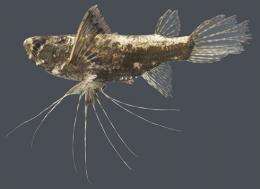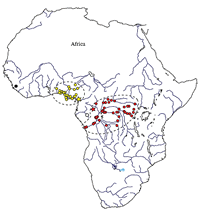Surprising genetics of the African butterfly fish

The African butterfly fish is a remarkable fish. Individuals in different populations look the same but they differ genetically by a huge amount, more than the difference between humans and chimpanzees, scientists report this week.
There are 2 populations of African butterfly fish, Pantodon buchholzi, one living in the Congo Basin and the other in the Niger Basin. They look so similar even experts struggle to tell them apart.
However, a team of scientists including fish expert Sébastien Lavoué at the Natural History Museum found striking differences in their genetic information; the genetic sequences (mitochondrial genome) of the African butterfly fish differed by 15% between the Congo and Niger populations.
This high figure surprised the team, as within individuals of the same species, you would normally expect a difference of only 2 or 3%. In fact, this 15% difference is more typical of what you would find within a whole fish family.
‘It was unexpected to find so much genetic divergence in Pantodon ,’ says Lavoué. ‘Especially as no one had reported any morphological variation in the species since its formal description in 1876.’
Separated for over 50 million years
Using state-of-the-art methods to estimate divergence times, the team found that this genetic separation had occurred more than 57 million years ago.
During this time, you would expect physical characteristics of individuals to change and adapt to their environment.
Additionally, the fish's habitat went through some major climatic changes. But the physical features of the African butterfly fish stayed the same.
It is rare to find living animals that have remained unchanged for so long. They are known as living fossils.
Horseshoe crabs, lampreys, plethodontid salamanders and coelacanths are some of the other few examples.
‘These results call for additional work to understand how and why the morphology of this fish stayed unchanged over tens of millions of years,’ adds Lavoué.

African butterfly fish
The African butterfly fish is a small freshwater fish with such distinctive characteristics that it is the only species in the family Pantodontidae.
They live in small African rainforest creeks, spending their lives swimming at the water's surface. They are extremely well adapted to their environment with a brownish colour giving them camouflage, and they are also able to breath air.
Their visual system in particular perfectly fits their way of life enabling Pantodon to see both in air and water at the same time.
They also have unique wing-like pectoral fins that allow ballistic jumping to escape predators or jump to catch prey.
Museum fish collection
For this research, the team studied fish specimens looked after in the Museum’s collection.
‘The Natural History Museum’s African butterfly fish collection is particularly significant to the study of evolutionary biology of this fish because it includes one of the type specimens used to describe Pantodon more than 100 years ago,’ explains Lavoué.
Future studies
The genetic differences between the 2 populations of African butterfly fish are so great that they may no longer be able to breed with each other.
This means they could be 2 cryptic species, species that are reproductively isolated but morphologically very similar.
Scientists would need to do further studies on their distinctiveness, based not only on morphology, but also on genetics and behaviour.
Whatever the outcome of these future studies, the new findings reveal the African butterfly fish is a useful living fossil species for scientists to study evolutionary processes in.
Provided by American Museum of Natural History















